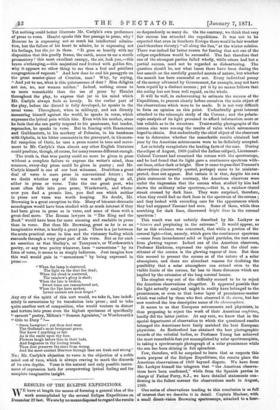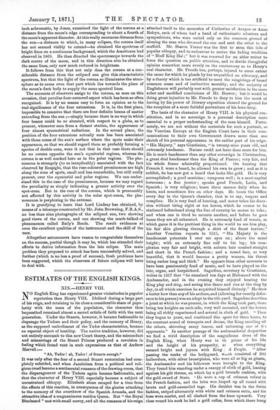RESULTS OF THE ECLIPSE EXPEDITIONS.
WE have at length the means of forming a general idea of the work accomplished by the several Eclipse Expeditions on December 22 last. We are by no meansdisposed to regard the results
so despondently as many do. On the contrary, we think that very fair success has attended the expeditions. It was not to be expected that even in Southern Europe there would be fair weather (and therefore victory) "all along the line," at the winter solstice. There was indeed far better reason for fearing that not one of the eclipse expeditions would be successful. The fact therefore that one of the strongest parties failed wholly, while others had but a partial success, need not be regarded as disheartening. The question should be, not what losses there have been daring the last assault on the carefully guarded secrets of nature, but whether the assault has been successful or not. Every individual penny of the money advanced by Government, for example, may not have been repaid by a distinct success ; yet it by no means follows that the outlay has not been well repaid, on the whole.
It will be well, in endeavouring to estimate the success of the Expeditions, to present clearly before ourselves the main object of the observations which were to be made. It is not very difficult to form an opinion on this point. Undoubtedly great interest attached to the telescopic study of the Corona ; and the polaris- copic analysis of its light promised to afford information more or less reliable as to its structure. Trustworthy photographs of the corona also were among the results of value which astronomers hoped to obtain. But undoubtedly the chief object of the observers was to determine whether the remarkable results obtained last year by the American astronomers were to be definitely accepted.
Let us briefly recapitulate the leading facts of the case. During the eclipse of August, 1868 (called the Indian eclipse), Lieutenant- Colonel Tennant had examined the corona with the spectroscope, and he had found that its light gave a continuous spectrum with- out lines, either dark or bright. How it came to pass that Tennant's observations (incorrectly quoted, perhaps) came to be misinter- preted, does not appear. But certain it is that, despite his owa plain statement to the contrary, the American observers were under the impression that the corona when studied by him had shown the ordinary solar spectrum,—that is, a rainbow-tinted streak crossed by dark lines. They were surprised, therefore, when they could find no dark lines in the spectrum of the corona ; and they looked with exceeding care for the appearances which they had supposed Tennant had seen. Some of them, while thus searching for dark lines, discovered bright lines in the corona' spectrum !
This result was not unfairly described by Mr. Lockyer as "bizarre and perplexing in the extreme." It would appear, so far as this evidence was concerned, that while a portion of the coronal light—that, namely, which gave the continuous spectrum. —came from incandescent solid or liquid particles, the rest came from glowing vapour. Indeed one of the American observers, Professor Harkness, expressed the opinion that the chief con- stituent of the corona is the glowing vapour of iron. But then this seemed to present the corona as of the nature of a solar atmosphere, and there are abundant reasons for doubting the possibility that a solar atmosphere can extend even to the visible limits of the corona, far less to those distances which are implied by the extension of the long coronal beams.
The simplest way out of the difficulty seemed to be to reject the American observations altogether. It appeared possible that the light actually analyzed might in reality have belonged to the prominences, or even to that lower layer of prominence-matter which was called by those who first observed it the sierra, but has now received the less descriptive name of the chromosphere.
It seems to us that European astronomers and physicists, in thus proposing to reject the work of their American confreres; hardly did the latter justice. At any rate, we know that in the special department of observation to which the questioned results belonged the Americans have fairly matched the best European physicists. As Rutherford has obtained the best photographic records of the celestial bodies, so Professor Young has achieved the most remarkable feat yet accomplished by solar spectroscopists, in taking a spectroscopic photograph of a solar prominence while the sun has been shining in full splendour.
Few, therefore, will be surprised to learn that as respects this main purpose of the Eclipse Expeditions, the results place the American observations of 1869 beyond dispute. We have from Mr. Lockyer himself the telegram that " the American observa- tions have been confirmed," while from the Spanish parties in charge of Father Perry, S.J., we have detailed statements con- firming in the fullest manner the observations made in August, 1869.
One series of observations tending to this conclusion is so full of interest that we describe it in detail. Captain Maclear, with a small direct-vision Browning spectroscope, attached to a four-
inch achromatic, by Jones, examined the light of the corona at a distance from the moon's edge corresponding to about a fourth of the moon's apparent diameter. At this really enormous distance from the sun—a distance to which, in many eclipses, the corona itself has not seemed visibly to extend—he obtained the spectrum of bright lines on a continuous background, which the Americans had observed in 1869. He then directed the spectroscope towards the dark centre of the moon, and in this direction also he obtained the same lines, only now much reduced in brightness.
It follows from this that not only does the corona at a con- siderable distance from the eclipsed sun give this characteristic spectrum, but that the light of the corona so illuminates the atmo- sphere as to cause even that part which lies towards the place of the moon's dark body to supply the same spectral lines.
The accounts of observers assign to the corona, as seen on this occasion, that peculiar four-cornered aspect which has been so often recognized. It is by no means easy to form an opinion as to the real significance of the four extensions. It is, in the first place, impossible to conceive that there are four definite beams of matter extending from the sun ;—simply because there is no way in which four beams could be so situated, with respect to a globe, as to present, whenever seen from a distant station, the appearance of four almost symmetrical radiations. In the second place, the position of the four extensions actually seen has been associated with those zones of the sun's surface where the spots make their appearance, so that we should regard them as probably forming a species of double cone, were it not that in that case there should be no corona opposite the sun's equatorial regions, whereas the corona is as well marked here as in the polar regions. The phe- nomena is strangely (to us inexplicably) associated with the fact observed by Reapighi, that the rose-coloured prominences are high along the zone of spots, small and leas remarkable, but still really present, over the equatorial and polar regions. We can under- stand this in the case of the prominences, because we may regard the peculiarity as simply indicating a greater activity over the spot-zone. But in the case of the corona, which is presumably not affected by this activity in the solar spot-zones, the phe- nomenon is perplexing in the extreme.
It is gratifying to learn that Lord Lindsay has obtained, by means of a telescope constructed by Mr. John Browning, F.R.A.S., no less than nine photographs of the eclipsed sun, two showing good views of the corona, and one showing the much-talked-of phenomenon called Baily's Beads. The result evidences at once the excellent qualities of the instrument and the skill of the user.
Altogether astronomers have reason to congratulate themselves on the success, partial though it may be, which has attended their efforts to derive information from the late eclipse. The main problem they proposed to attack has been successfully solved, and further (which is no less a proof of success), fresh problems have been suggested, which the observers of future eclipses will have to deal with.































 Previous page
Previous page